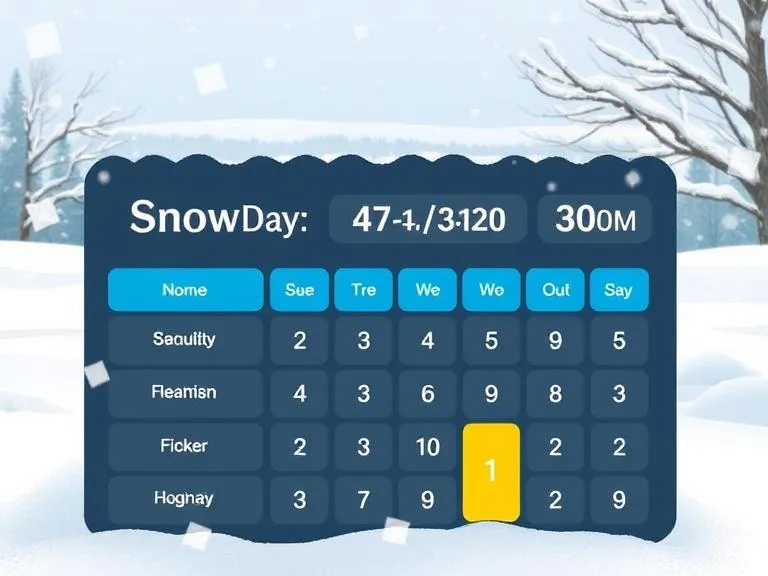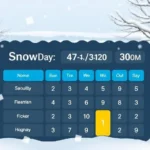Snow Day Calculator When winter storms approach, students across the country cross their fingers and hope for that magical announcement: “School is canceled!” The snow day has been a beloved tradition for generations of schoolchildren. But in today’s technology and weather forecasting world, is there a way to predict these unexpected days off? Enter the snow day calculator, a tool that has become increasingly popular among hopeful students and curious parents alike.
Snow Day Calculator
What Is a Snow Day Calculator?
A snow day calculator is a prediction tool that estimates the likelihood of school cancellations due to winter weather. These calculators take into account various factors including:
- Forecast snowfall amounts
- Expected temperatures
- Wind speed predictions
- Timing of the storm
- Your school district’s history of closing
- Local geography and road conditions
Most snow day calculators are available online as free websites or apps. Users typically enter their location, the weather forecast, and sometimes additional information about their specific school district. The calculator then produces a percentage chance that the school will be canceled.
The most popular snow day calculator was created by David Sukhin when he was just a middle school student himself. His calculator, which began as a simple computer program, now processes data for schools across the United States and has millions of users each winter.
How Do Snow Day Calculators Work?
Behind the seemingly simple interface of a snow day calculator lies a complex system of data analysis. These tools work by combining:
Weather Data Analysis
The calculator pulls current weather forecasts from reliable sources like the National Weather Service. It looks at:
- Predicted snowfall amounts for your specific area
- Temperature ranges before, during, and after the storm
- Ice potential, which often poses more danger than snow
- Wind speeds that could cause blowing snow or power outages
Historical School Closing Patterns
One of the most important factors in predicting a snow day is understanding how your specific school district has responded to similar weather events in the past.
Some districts close at the mere mention of snow, while others have been known to stay open through significant storms. A good snow day calculator builds a database of past closing decisions to better predict future ones.
Timing Considerations
The timing of a storm greatly affects the likelihood of a snow day. Storms that hit:
- Overnight or during early morning hours (when buses would be on the road) are more likely to cause cancellations
- During school hours might lead to early dismissals rather than full cancellations
- On weekends or holidays don’t affect school schedules
Regional Factors
A snow day calculator must account for regional differences in winter weather preparedness:
- Northern states with regular snowfall typically have better snow removal equipment
- Southern states might close with minimal snow since they lack snow removal resources
- Urban vs. rural districts face different challenges with road clearing
- Mountainous regions have different considerations than flat areas
The Science Behind Snow Day Predictions
Creating an accurate snow day calculator requires understanding both meteorology and statistics. Let’s look deeper at how these systems make their predictions:
Weather Forecasting Basics
Modern weather forecasting relies on:
- Doppler radar systems that track precipitation
- Satellite imagery showing cloud patterns
- Computer models that simulate atmospheric conditions
- Ground observations from weather stations
These tools help meteorologists predict not just if it will snow, but how much, what type of snow (wet, dry, etc.), and how it might affect travel conditions.
Predictive Algorithms
A sophisticated snow day calculator uses algorithms that:
- Weigh different factors based on importance (heavy snow might be weighted more heavily than cold temperatures)
- Account for uncertainty in weather forecasts
- Calculate probabilities rather than simple yes/no answers
- Learn from past predictions to improve future accuracy
Machine Learning Improvements
The newest generation of snow day calculators uses machine learning to:
- Identify patterns in school closing decisions that humans might miss
- Adapt to changing climate conditions
- Personalize predictions based on user feedback
- Improve accuracy over time as more data is collected
Popular Snow Day Calculators Available Online
If you’re hoping for a day off school, several snow day calculators have gained popularity:

The Original Snow Day Calculator
Developed by David Sukhin, this calculator has been featured on major news networks and boasts millions of users. The calculator:
- Covers most US regions
- Has a simple, user-friendly interface
- Provides percentage chances rather than definite answers
- Has built a strong reputation for accuracy
Snow Day Predictor Apps
Several smartphone apps now offer snow day predictions, including:
- Snow Day Calculator Pro
- Snow Day Predictor
- Winter Storm School Closings
These apps often include:
- Push notifications about changing predictions
- Maps showing storm paths
- Historical accuracy statistics
- User forums for sharing local information
Local News Station Calculators
Many local television stations have created their snow day calculators that:
- Focus specifically on school districts in their viewing area
- Incorporate local knowledge about district closing patterns
- Connect directly to their meteorologists’ forecasts
- May include additional features like traffic conditions and power outage tracking
Factors That Influence School Closing Decisions
Understanding what goes into a school closing decision helps explain why snow day calculators consider so many factors:
Safety Concerns
The primary factor in any closing decision is student and staff safety:
- Road conditions for buses and student drivers
- Sidewalk conditions for walking students
- Parking lot safety at school facilities
- Potential for accidents during transportation
Operational Considerations
Schools must also consider:
- Whether school buildings can be properly heated
- If parking lots and walkways can be cleared in time
- Staff ability to reach the buildings
- Potential for power or water outages
Timing Factors
The timing of storms greatly influences decisions:
- Early morning storms create the hardest decisions for administrators
- Overnight accumulation that exceeds road crew capabilities
- Storms that intensify during school hours might lead to early dismissals
- Multi-day storms may lead to consecutive snow days
Administrative Pressure
School administrators must balance:
- Pressure to maintain the academic calendar
- Parent concerns about childcare
- State requirements for instructional hours
- The limited number of built-in snow days in the calendar
How Accurate Are Snow Day Calculators?
The burning question for many students: can you trust a snow day calculator?
Success Rates
Most popular snow day calculators claim accuracy rates of:
- 70-85% for predictions above 90% probability
- Slightly lower accuracy for borderline cases
- Better accuracy in regions with more predictable winter weather patterns
Limitations
Even the best snow-day calculators face challenges:
- Weather forecasts themselves have inherent uncertainty
- School administrators may consider factors not in the calculator
- Last-minute changes in storm tracks can upend predictions
- Some districts make decisions based on factors like teacher unions or administrative policies that calculators can’t account for
User Feedback
What do users say about snow day calculator accuracy?
Many students report that predictions in the 50-70% range often go either way, while predictions above 90% tend to be quite reliable. However, there’s likely some confirmation bias in these reports, as disappointment from a wrong prediction may be remembered more clearly than a correct one.
The Future of Snow Day Predictions
As technology advances, snow day calculators continue to evolve:
Climate Change Impacts
Climate change is affecting winter weather patterns, which means:
- Some regions experience more extreme winter storms
- Others see fewer traditional snow events
- More mixed precipitation events (rain/snow/ice) that are harder to predict
- Greater variability in winter patterns year-to-year
Snow day calculators must adapt to these changing patterns to maintain accuracy.
Remote Learning Considerations
The COVID-19 pandemic introduced widespread remote learning capabilities, which has changed the snow day landscape:
- Some districts now use “remote learning days” instead of canceling school
- This affects how snow-day calculators must evaluate closing probabilities
- Some states have new laws about whether remote days count as instructional time
- Many districts still preserve traditional snow days for student well-being
Technological Improvements
Future snow day calculators might incorporate:
- Hyperlocal weather data from personal weather stations
- Real-time road condition information from transportation departments
- Artificial intelligence that better predicts administrative decisions
- Integration with school notification systems
Tips for Using Snow Day Calculators Effectively
If you’re hoping to predict your next day off, here’s how to get the most accurate results:
Enter Accurate Information
The output of any snow day calculator depends on the input:
- Use reliable weather forecasts from sources like the National Weather Service
- Know your school district’s exact location (not just your city)
- Understand your district’s history with closing decisions
- Enter the correct day of the week and time of year
Check Multiple Sources
Don’t rely on just one prediction:
- Compare results from different snow day calculators
- Check local meteorologists’ opinions
- Look at social media for local road condition reports
- Monitor your school district’s communications
Understand Probability
Remember that a snow day calculator provides probabilities, not guarantees:
- A 75% chance means 1 in 4 times, the prediction will be wrong
- Even high probabilities leave room for error
- The closer to the weather event, the more accurate predictions tend to be
DIY Snow Day Prediction
Want to make your predictions without a calculator? Consider these factors:
Watch the Forecast Closely
Pay attention to:
- Forecast snow amounts in your specific area
- The timing of the heaviest precipitation
- Temperature trends before and after the storm
- Wind forecasts that could cause blowing and drifting
Know Your District’s Patterns
Observe how your school handles winter weather:
- How many inches typically trigger a closing?
- Does your district tend to close preemptively or wait until morning?
- How do they handle early dismissals versus full cancellations?
- Do they follow the lead of neighboring districts?
Consider the Context
The broader context matters:
- Is this the first snow of the season or the tenth?
- Are there major events scheduled at school tomorrow?
- Has the district already used all its built-in snow days?
- Are there other factors (like power outages or extreme cold) that might influence decisions?
Snow Day Alternatives
As education evolves, so do alternatives to the traditional snow day:
Delayed Openings
Many districts opt for:
- Two-hour delays to allow for road clearing
- Modified bus routes that avoid dangerous areas
- Adjusted schedules that preserve some instructional time
Remote Learning Days

The pandemic normalized remote instruction, leading to:
- Synchronous online classes during weather events
- Asynchronous assignments to complete during storms
- Hybrid approaches that combine flexibility with structure
Built-In Make-Up Days
Most school calendars now include:
- Designated make-up days built into the calendar
- Conversion of teacher work days to instruction if needed
- Extended school days to make up lost time
- Potential extension of the school year in extreme cases
Conclusion
The snow day calculator represents a fascinating intersection of meteorology, education policy, and technology. While no prediction tool can be perfect, these calculators offer students and families a glimpse into the complex decision-making process behind school closings.
Whether you’re a student hoping for a day of sledding or a parent preparing for childcare arrangements, understanding how snow day calculators work can help you better prepare for winter’s uncertainties. Remember that even with the best technology, Mother Nature still has the final say!
For those crossing their fingers for a day off, may the odds (and the snow day calculator) be ever in your favor!
FAQs for the Snow Day Calculator:
1. How does the Snow Day Calculator work?
The Snow Day Calculator estimates the probability of school closures based on snowfall amount, temperature, and other weather factors. It analyzes input data and provides an approximate percentage chance of a snow day.
2. Is the Snow Day Calculator accurate?
While the calculator offers a probability estimate based on historical data and weather trends, actual school closures depend on school district policies, road conditions, and local weather authorities.
3. Can I use this calculator for any location?
Yes! As long as you input accurate snowfall and temperature data for your area, the calculator can generate an estimated snow day probability.
4. Does the calculator consider wind chill and ice?
Currently, the tool calculates probabilities based on snowfall and temperature. Future updates may include factors like wind chill, road conditions, and ice accumulation.
5. Is the Snow Day Calculator free to use?
Yes, the Snow Day Calculator is completely free and available for anyone to use online. It helps students, parents, and teachers plan for possible school closures.
Let me know if you need any modifications! 😊






